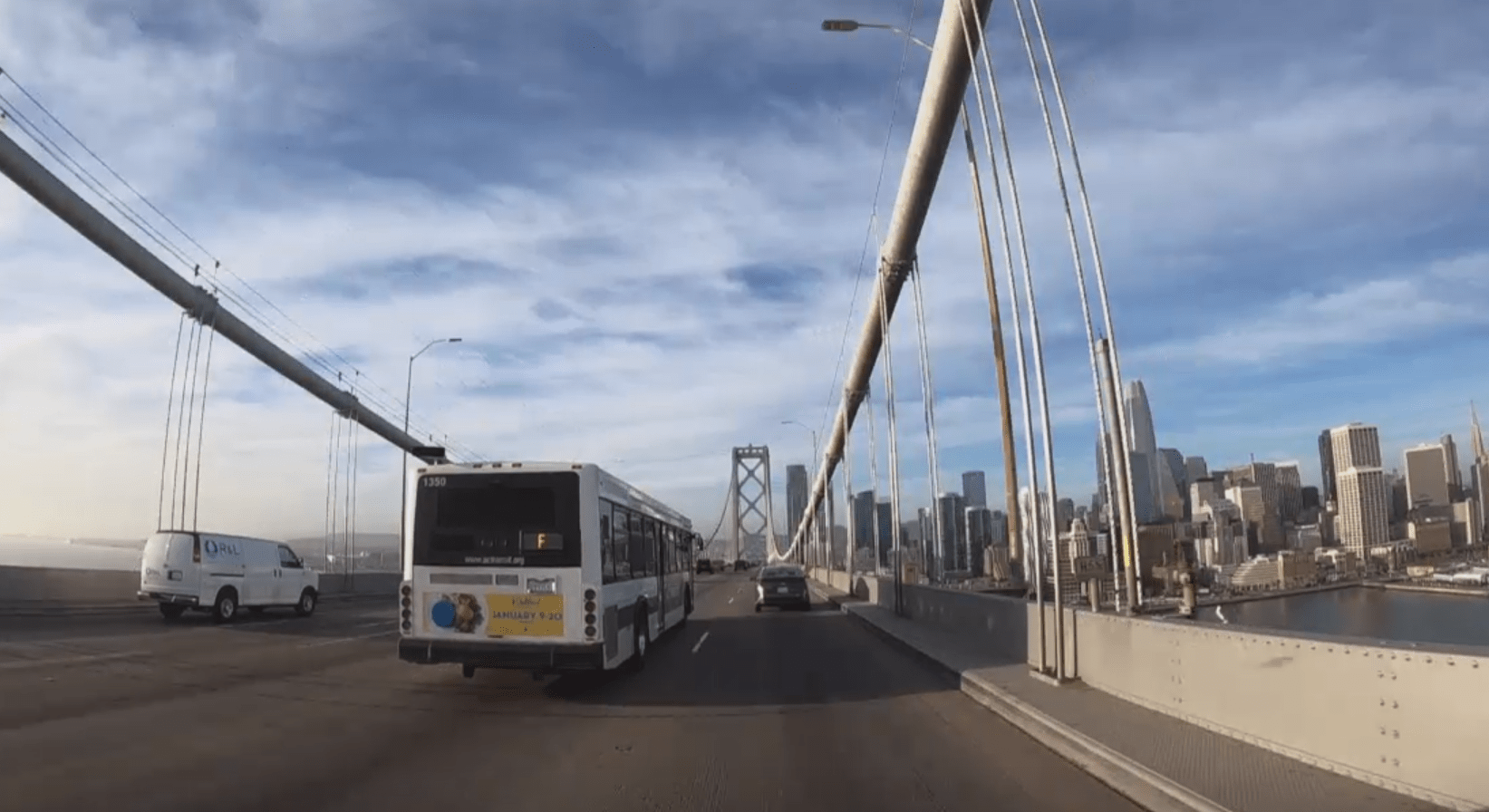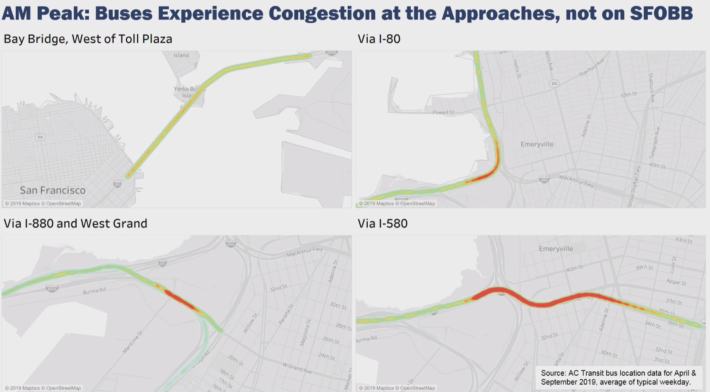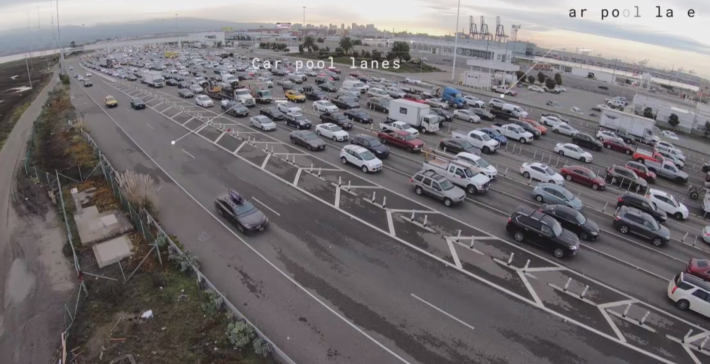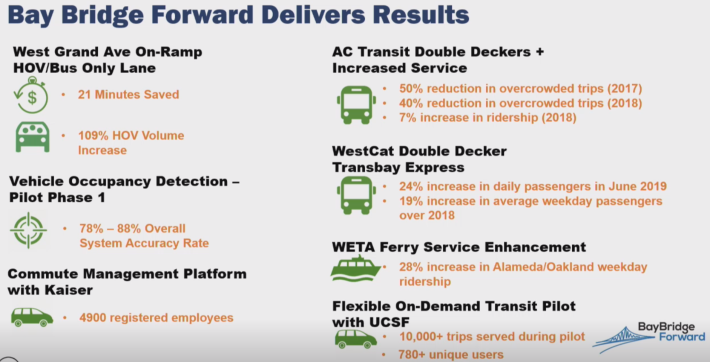Next Steps for a Bus Lane on the Bay Bridge
4:24 PM PST on February 12, 2020

An AC Transit bus on a rare, congestion free trip to San Francisco. Photo: MTC
At today's meeting of the Bay Area Toll Authority Oversight Committee (BATA) of the Metropolitan Transportation Commission (MTC), which makes decisions about the Oakland Bay Bridge, for the commissioners it wasn't a question of whether to put bus-only lanes on the bridge and its approaches--it was how to get it done.
However, their staff seemed to see things differently.
"If we closed a lane on the bridge to traffic today, we would make the problem worse," said Andrew Fremier, MTC’s Deputy Executive Director for Operations, in a presentation to the commission. "The Bay Bridge itself is not where the significant delays are...it's the approaches where you see the problems."
He pointed out that in 1962, when a bi-directional bus lane was piloted, it "...did well and increased ridership and saved time, but Bay Area was a very different place today." The population has doubled, he explained, and the bridge and its approaches are significantly reconfigured.

He said that it would be necessary to improve alternatives to driving across the bridge to permit removing a lane of traffic from private cars--and that adding transit lanes on the approaches and adjoining freeways would result in more time savings for bus riders. "We’d need a 20 percent modeshift [to transit] to be successful," with a transit-only lane on the bridge, he added.
Commissioners and advocates who spoke at the meeting disagreed with Fremier's conclusions and argued that the region should start preparing immediately for bus-only lanes on the bridge itself.
"The takeaway is that we’re going to need a bus lane on the Bay Bridge pretty soon," said Nick Josefowitz, director of policy at SPUR and a BATA commissioner. "When you look at the number of buses--69 per hour--and they're are all getting delayed six minutes on the bridge, that’s a lot of combined passenger delay."
Others pointed out that the delays are averages--and the problem is without a dedicated transit lane on the bridge, everyone who uses a Transbay bus has to contend with large variations in trip times. "On a good day it can take 22 minutes, on a bad day it can take 42 minutes--you never know," said Jean Walsh, an advocate who addressed the board.
"Reliability is key to getting people using public transportation," said Gina Papan, another commissioner, adding that to get to the 20 percent modeshift the MTC is shooting for, they have to make transit more consistent and attractive.

"Every day, tens of of thousands of people who take buses are forced to slog through traffic and we’re not utilizing our investment in the Transbay Transit Center," said Arielle Fleisher, Transportation Policy Director, who also spoke at the meeting.
Fremier cautioned the board that it will have to decide if bus-only lanes should include van pools and private shuttles. And if the lane should be physically protected, which would be desirable but complicated to implement because of the configuration of the ramps leading to the bridge. Without expensive changes, buses would have to work their way across multiple lanes of traffic just to reach the entrance of a bus-only lane.

As to the contention of whether to focus on the approaches or the bridge itself, the commissioners seemed to conclude that both are worth doing. "It’s time we do something that really benefits Alameda County and Contra Costa residents in getting across that bridge. I’m one vote that says we need to move forward with this immediately," said Alameda County Supervisor Scott Haggerty, who sits on the board.
Josefowitz said the commission needs to quickly take advantage of renewed interest in a bus-only lane, from Sacramento and elsewhere.
Fremier said, with board approval, they can start improvements and creating bus-only lanes in a few years for between "$10 and 20 million" with funds that are already assigned from past measures and the $40 million "Bay Bridge Forward" program, announced in 2016, which has already been used to help buy high-capacity, double-decker buses and increase ferry services across the Bay.

Meanwhile, the commission instructed MTC staff to work up a funding plan for bus-only lanes on the approaches and the bridge itself over the next two months.
Stay in touch
Sign up for our free newsletter
More from Streetsblog San Francisco
Commentary: Making Valencia Better for Business
Curbside protected bike lanes with curbside parklets deliver on much-needed economic benefits for merchants while ensuring safety for all




